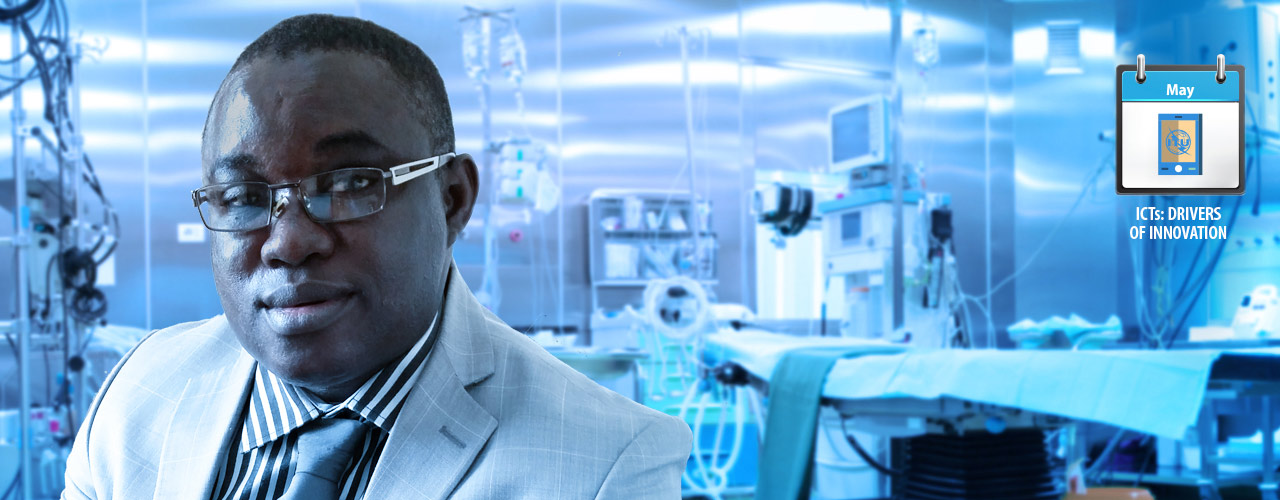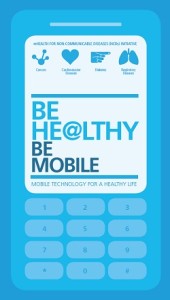It is predicted that by 2030, 366 million people will be living with diabetes worldwide. Baye Oumar Gueye explains how mobile health solutions have revolutionized access to healthcare for diabetics in Senegal, and what this means for the treatment of NCDs around the world.
I have lived what many people would consider to be an active life: I have had a great education, travelled around the world, and had a successful and exciting career. But at the age of seven, I was diagnosed with diabetes.
Managed properly, the disease does not tend to affect my day-to-day life. I completed two degrees at university, studying my Bachelors in Philosophy, followed by a Masters in Human Resource Management at Bordeaux Ecole de Management (BEM). I then worked my way up the ladder at SudFM, Senegal’s number one private radio station, from Reporter to Desk Chief, to Senior Reporter, to Editor-in-Chief, and in September 2014, to Director-General.
While it is true that diabetes radically alters your lifestyle – ensuring that your insulin levels are within a safe range throughout the day and closely monitoring your diet and exercise – managed properly and effectively, you can live a full and healthy life. Yet, this depends on receiving the right information for best practice, something that is not always easy to obtain in areas where medical services are hard to reach or under-served. ICTs are the most effective means to achieving the effective dissemination of information; today, mobile phones have a global reach of nearly 7 billion subscriptions, 3 billion people have access to the Internet and radios are near ubiquitous. Tapping into these services can provide direct, low-cost, engaging and innovative solutions to accessing healthcare for those suffering from this lifelong disease.
This innovative use of technology reminds me of a quote from my favourite philosopher, Karl Marx, “until now, philosophers have only interpreted the world in various ways; now is the time to transform it.” ICTs have the ability to dramatically improve the quality of life of people living with diabetes and non-communicable diseases (NCDs) more widely, such as cardiovascular diseases, cancer, and kidney disease. 38 million deaths were caused by NCDs in 2012. The World Health Organization (WHO) estimate that 80 per cent of premature heart disease, stroke and diabetes can be prevented; we must work to deploy mobile technologies to ensure that common modifiable risk factors such as tobacco use, unhealthy diets, raised blood pressure and blood sugar, are reduced.
What is ‘Be He@lthy, Be Mobile’?
Recognizing that mobile solutions are available, accessible, portable and a cost effective means to minimize illness and disability, ITU and the World Health Organization (WHO) launched the global mHealth programme Be He@lthy, Be Mobile in October 2012 which focuses on the use of mobile technology to improve the prevention and treatment of NCDs. To date, the Be He@lthy, Be Mobile initiative has been working with Costa Rica, Zambia, Norway, Philippines, United Kingdom, Senegal, Tunisia and India to implement mHealth programmes. Learn more here.
Supporting Senegal’s Healthcare System
Because of changing lifestyles and diets, most countries in Africa are seeing increased diagnoses of diabetes – and Senegal is no exception. Over four per cent of the adult population lives with the disease across the country, but this could be as high as 10 per cent in some areas. However, these are just estimated numbers: there are still many undiagnosed cases, especially in remote and rural areas. Surveys are being conducted nationwide to discover the true number of people living with the disease.
I am proud to be Secretary-General for the Association Sénégalaise de Soutien Aux Diabétiques (ASSAD). For close to 50 years, we have supported people who live with diabetes to help them independently manage their health and live active lives. Through our scientific, legal, medical and social commissions, we raise awareness about diabetes and its treatment, both to people with diabetes and the general public.
In 2014, we teamed up with ITU and WHO to launch their ‘Be He@lthy, Be Mobile’ mDiabetes programme in Senegal. Senegal is well suited to this innovative programme; 83 per cent of the population has a mobile telephone, 40 per cent of which are smartphones capable of receiving images and videos.
The initiative was divided into four stages: mSensibilisation (awareness-raising); mFormation (training); mEducation (education); and Patient Monitoring (follow-up).
The programme targets four relevant groups simultaneously: the general public; healthcare workers who may not be trained in chronic diseases; diabetics; and diabetics in a high risk category with known complications. Targeting these four groups at the same time means that there will be a higher level of awareness about the disease, its symptoms and risks, and how to prevent further complications. It is mobile technology alone which allows us to scale at this level, to set such comprehensive goals and to mobilize all the key stakeholders in one go.
National eHealth Strategy Toolkit
“There is strong evidence that smart, innovative solutions, such as mobile technologies can facilitate healthcare, save lives and cut healthcare costs on an unprecedented scale and can make a real difference to people around the world.” – Mr. Yushi Torigoe, Deputy Director of ITU’s Telecommunication Development Bureau (BDT)
The National eHealth Strategy Toolkit is an expert, practical guide that provides governments, their ministries and stakeholders with a solid foundation and method for the development and implementation of a national eHealth vision, action plan and monitoring framework. The Toolkit can be easily adapted to suit various levels of national development.
mRamadan Pilot
A large majority of the Senegalese population is Muslim (94 per cent). Ramadan is a holy celebration in the Muslim faith where practitioners must fast for a month, not consuming foods or liquids from sunrise to sunset. Consequently, Ramadan is a risky period for diabetics: periods of fasting throughout the day are usually followed by a high sugar intake when consumption resumes in the evening. Because of this dietary irregularity, health authorities witness a peak in the urgent hospitalization of people with uncontrolled diabetes.
mRamadan, the first deployment of the mDiabetes programme, was launched in 2014 to raise awareness about the dangers associated with this holy holiday and how to fast safely. People living with diabetes or healthcare professionals who had an interest in receiving recommendations about diabetes and fasting, could apply to receive SMS messages before, during and after Ramadan, free of charge.
Four weeks before Ramadan, we sent users one message a day to help them prepare for the month of fasting. This reduced to two a week during Ramadan. Typical messages included: ‘drink one litre of water every morning before you begin fasting’, ‘take care not to overheat and watch out for foods high in sugar such as dates’, and ‘ask your doctor to adapt the dose and timing of your diabetes medication before you fast’. In total, 80,000 free SMS messages were distributed to more than 2,000 users across the country.
The information campaign was highly successful, with 99 per cent of those who participated in the pilot saying that they would like to receive the messages again. For me, both as Secretary-General of ASSAD and as a person living with diabetes, my proudest moment was seeing the impact beyond projected outcomes; people did not just receive the messages that we sent out, but saved them and shared them with family, friends and other patients. Mobile allowed the message to be treated as dynamic content easily shared and amplified beyond the base population of subscribers.
NCDs, nutrition and ICTs
Limited access to health services can have serious consequences for someone living with diabetes, yet ICTs can be leveraged to provide a healthcare platform which is always available. (…) Building on mHealth initiatives such as the Be He@lthy, Be Mobile programme, mobile phone technology can be harnessed to influence behaviours that can help to control the world’s biggest killers: non-communicable diseases.
Extract from ITU Blog, ‘World Health Day: Food Safety, NCDs and ICTs’ (7 April 2015)
ITU’s Role
ITU was an active facilitator, bringing technical, logistical and organizational expertize to help see the project through from beginning to end. As a nationally deployed programme, we needed to reach different users; having previous experience with public-private partnerships, ITU helped coordinate the participation of different telecommunications operators. With their assistance, we were able to stick to our schedule and help get people with diabetes safely through Ramadan.
Future Mobile Deployments
This year, we hope to reach between 10 – 15 thousand users with the mRamadan programme. But having seen the benefits that this programme can bring to people with diabetes, I would like to see the mHealth initiative extended not just within Senegal, but across the region, the continent – and even the world.
It is highly scalable, which is the beauty of mobile tech, and certainly has incredible potential if applied to other NCDs, but we need to use every possible channel of communication to reach the largest number of people possible. Other media channels will be increasingly valuable for propagating health messages, from social media networks to radio, to print media and TV. And we cannot underestimate the power of cultural channels such as music, art and film. We must blend every medium possible to ensure that risk factors are properly managed to help save lives.
Standardization
Learn about ITU-T’s work in e-health standardization here.
Devices such as wireless blood pressure cuffs, weight scales and a wide range of activity trackers can play a critical role in the prevention and improved management of chronic conditions such as diabetes, hypertension and heart disease. Establishing global interoperability standards – such as Recommendation ITU-T H.810 which contain Continua Health Alliance’s Design Guidelines providing “Interoperability design guidelines for personal health systems” – will stimulate innovation and nourish the personal connected health ecosystem. Read the full press release here.
Recommendation ITU-T Y.2065, “Service and capability requirements for e-health monitoring services”, will push the evolution of the Internet of Things (IoT) technologies for e-health towards lower cost, higher efficiency, enhanced quality of experience and diversified smart services for health professionals, health organizations and ordinary people. Read more here.
ITU/WHO’s ‘Be He@lthy, Be Mobile’ mHealth initiative makes an active contribution to people wanting to live and participate normally in society, assisting individuals to manage their disease. With global diabetes diagnoses predicted to increase exponentially by 2030, we must make these types of innovative initiatives readily available to help combat the burden on healthcare services and accompany people through their lifelong illness.
m-Powering Initiative
Beyond mHealth, access to, and use of, ICT services brings innumerable social opportunities and helps to stimulate economic growth in areas as diverse as m-education, m-government, m-banking and m-sport. Launched in 2012, ITU’s m-Powering Initiative harnesses the global reach of today’s technology to open new models of development. The initiative extends the benefits of mobile technology to all strata of society through reliable mobile teleconnectivity, the provision of affordable services and use of the latest technology. Learn more here.


